Dinosaurus is an extinct genus of therapsid of controversial affinities. Its type and only species is Dinosaurus murchisonii. It is only known from a partial snout from the Permian of Russia. Its taxonomic history is intertwined with several other poorly-known Russian therapsids, particularly Rhopalodon, Brithopus, and Phthinosuchus.

A therapsid is a member of the clade Therapsida, which is a major group of eupelycosaurian synapsids that includes mammals and their ancestors and close relatives. Many of the traits today seen as unique to mammals had their origin within early therapsids, including limbs that were oriented more underneath the body, as opposed to the sprawling posture of many reptiles and salamanders.

Pelycosaur is an older term for basal or primitive Late Paleozoic synapsids, excluding the therapsids and their descendants. Previously, the term mammal-like reptile had been used, and pelycosaur was considered an order, but this is now thought to be incorrect, and seen as outdated.

Dinocephalians are a clade of large-bodied early therapsids that flourished in the Early and Middle Permian between 279.5 and 260 million years ago (Ma), but became extinct during the Capitanian mass extinction event. Dinocephalians included herbivorous, carnivorous, and omnivorous forms. Many species had thickened skulls with many knobs and bony projections. Dinocephalians were the first non-mammalian therapsids to be scientifically described and their fossils are known from Russia, China, Brazil, South Africa, Zimbabwe, and Tanzania.
The Guadalupian is the second and middle series/epoch of the Permian. The Guadalupian was preceded by the Cisuralian and followed by the Lopingian. It is named after the Guadalupe Mountains of New Mexico and Texas, and dates between 272.95 ± 0.5 – 259.1 ± 0.4 Mya. The series saw the rise of the therapsids, a minor extinction event called Olson's Extinction and a significant mass extinction called the end-Capitanian extinction event. The Guadalupian was previously known as the Middle Permian.

Biarmosuchia is an extinct clade of non-mammalian synapsids from the Permian. Biarmosuchians are the most basal group of the therapsids. They were moderately-sized, lightly built carnivores, intermediate in form between basal sphenacodont "pelycosaurs" and more advanced therapsids. Biarmosuchians were rare components of Permian ecosystems, and the majority of species belong to the clade Burnetiamorpha, which are characterized by elaborate cranial ornamentation.
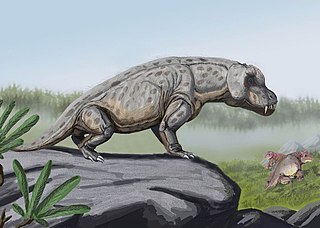
Anteosaurs are a group of large, primitive carnivorous dinocephalian therapsids with large canines and incisors and short limbs, that are known from the Middle Permian of South Africa, Russia, China, and Brazil. Some grew very large, with skulls 50–80 centimetres (20–31 in) long, and were the largest predators of their time. They died out at the end of the Middle Permian, possibly as a result of the extinction of the herbivorous Tapinocephalia on which they may have fed.

Therocephalia is an extinct clade of eutheriodont therapsids from the Permian and Triassic periods. The therocephalians ("beast-heads") are named after their large skulls, which, along with the structure of their teeth, suggest that they were carnivores. Like other non-mammalian synapsids, therocephalians were once described as "mammal-like reptiles". Therocephalia is the group most closely related to the cynodonts, which gave rise to the mammals, and this relationship takes evidence in a variety of skeletal features. Indeed, it had been proposed that cynodonts may have evolved from therocephalians and so that therocephalians as recognised are paraphyletic in relation to cynodonts.
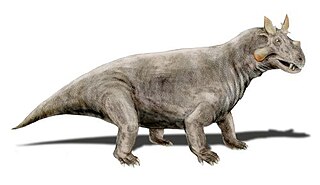
Estemmenosuchidae is an extinct family of large, very early herbivorous therapsids that flourished during the Guadalupian period. They are distinguished by horn-like structures, probably for display or agonistic behavior. Apart from the best known genus, Estemmenosuchus, the group is poorly known. To date, their fossils are known only from the Perm region of Russia.
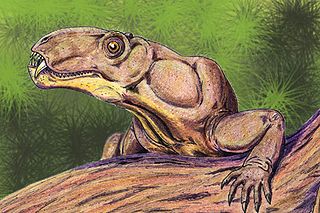
Phthinosuchus is an extinct genus of therapsids from the Middle Permian of Russia. Phthinosuchus is the sole member of the family Phthinosuchidae. Phthinosuchus may have been one of the most primitive therapsids, meaning that its ancestors may have branched off early from the main therapsid line.

Brithopus is an extinct genus of dinocephalian therapsids. It contains a single species, Brithopus priscus, known from fragmentary remains found in the Copper Sandstones near Isheevo, Russia.
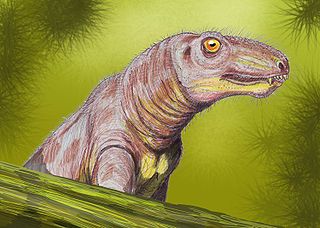
Microurania is an extinct genus of therapsids from the Middle Permian first named and described by Mikhaïl Ivakhnenko. It is known from a single partial skull found in the region of Orenburg, Russia. According to Kammerer, 2011, it likely represents the remains of a juvenile dinocephalian.

Venyukovia is an extinct genus of venyukovioid therapsid, a basal anomodont from the Middle Permian of Russia. The type and sole species, V. prima, is known only by a partial lower jaw with teeth. Venyukovia has often been incorrectly spelt as 'Venjukovia' in English literature. This stems from a spelling error made by Russian palaeontologist Ivan Efremov in 1940, who mistakenly replaced the 'y' with a 'j', which subsequently permeated through therapsid literature before the mistake was caught and corrected. Venyukovia is the namesake for the Venyukovioidea, a group of small Russian basal anomodonts also including the closely related Otsheria, Suminia, Parasuminia and Ulemica, although it itself is also one of the poorest known. Like other venyukovioids, it had large projecting incisor-like teeth at the front and lacked canines, although the remaining teeth are simple compared to some other venyukovioids, but may resemble those of Otsheria.
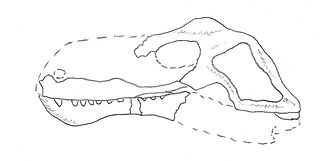
Dimacrodon is an extinct genus of non-mammalian synapsid from the latest Early Permian San Angelo Formation of Texas. It is distinguished by toothless, possibly beaked jaw tips, large lower canines and a thin bony crest on top of its head. Previously thought to be an anomodont therapsid related to dicynodonts, it was later found to lack any diagnostic features of anomodonts or even therapsids and instead appears to be a 'pelycosaur'-grade synapsid of uncertain classification.
Lycaenodon is an extinct genus of biarmosuchian therapsids from the Late Permian of South Africa. It is known from a single species, Lycaenodon longiceps, which was named by South African paleontologist Robert Broom in 1925. Both are small-bodied biarmosuchians. Two specimens are known, and both preserve only the front portions of the skull. These specimens come from the Cistecephalus Assemblage Zone of the Karoo Basin. Broom attributed the back portion of a third skull to Lycaenodon, but subsequent examiners considered it to belong to a gorgonopsian or dinocephalian and not a biarmosuchian. Most of the distinguishing features of Lycaenodon come from its palate. As a member of Biarmosuchia, the most basal group of therapsids, Lycaenodon shares many features with earlier and less mammal-like synapsids like Dimetrodon.

Niaftasuchus is an extinct genus of therapsids. Its type and only named species is Niaftasuchus zekkeli.

Raranimus is an extinct genus of therapsids of the Middle Permian. It was described in 2009 from a partial skull found in 1998 from the Dashankou locality of the Qingtoushan Formation, outcropping in the Qilian Mountains of Gansu, China. The genus is the most basal known member of the clade Therapsida, to which the later Mammalia belong.

Venyukovioidea is an infraorder of anomodont therapsids related to dicynodonts from the Permian of Russia. They have also been known as 'Venjukovioidea', as well as by the similar names 'Venyukoviamorpha' or 'Venjukoviamorpha' in literature. This in part owes to a misspelling by Russian palaeontologist Ivan Efremov in 1940 when he mistakenly spelt Venyukovia, the namesake of the group, with a 'j' instead of a 'y', which permeated through subsequent therapsid literature before the mistake was caught and corrected. The order Ulemicia has also been coined for a similar taxonomic concept in Russian scientific literature, which notably excludes Suminia and Parasuminia.
Phthinosaurus is an extinct genus of therapsids from the Middle Permian of Russia. The type species Phthinosaurus borrisiaki was named by Soviet paleontologist Ivan Yefremov in 1940 on the basis of an isolated lower jaw. Because this jaw provides few distinguishing characteristics, the evolutionary relationships of Phthinosaurus are poorly known. Yefremov named the family Phthinosuchidae in 1954 to include Phthinosaurus and the newly named Phthinosuchus, which was described on the basis of a crushed partial skull. American paleontologist Everett C. Olson placed both of these therapsids in the larger infraorder Phthinosuchia in 1961. In 1974 Leonid Tatarinov named the family Phthinosauridae to include Phthinosaurus alone, retaining Phthinosuchus within Phthinosuchidae.
Gorgodon is an extinct genus of basal synapsids. The genus is monotypic, known only from the type species Gorgodon minutus from the Early Permian of the southwestern United States. The only known remains of Gorgodon are two fossils consisting of fragments of the skull. Gorgodon was described and named by paleontologist Everett C. Olson in 1962 from the San Angelo Formation in Knox County, Texas. Based on what is known of Gorgodon—the squamosal, quadrate, and pterygoid bones of the back of the skull, the maxilla and premaxilla bones that make up the front of the skull, and several teeth—Gorgodon had a relatively large temporal fenestra and a pair large, conical caniniform teeth at the front of the jaw. Other distinguishing features of Gorgodon include the fused connection between the quadrate and squamosal bones and a long transverse process of the pterygoid.




















